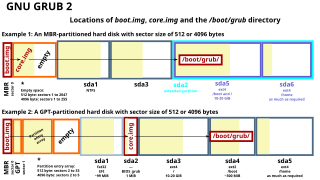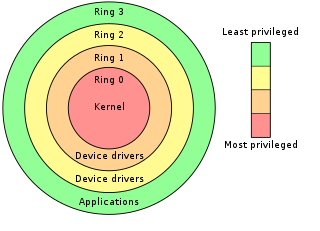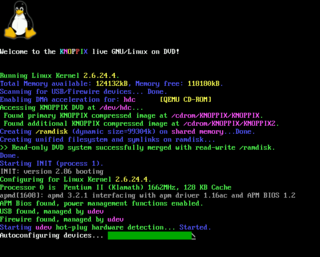 W
WApple Computer, Inc. v. Franklin Computer Corp., 714 F.2d 1240, was the first time an appellate level court in the United States held that a computer's operating system could be protected by copyright. As second impact, this ruling clarified that binary code, the machine readable form of software, was copyrightable too and not only the human-readable source code form of software.
 W
WAward Software International Inc. was a BIOS manufacturer founded in 1983, by Rene Vishney and Bob Stillman in San Jose, California. In 1984 the company moved its international headquarters to Los Gatos, California, United States.
 W
WIn computing, BIOS is firmware used to perform hardware initialization during the booting process, and to provide runtime services for operating systems and programs. The BIOS firmware comes pre-installed on a personal computer's system board, and it is the first software to run when powered on. The name originates from the Basic Input/Output System used in the CP/M operating system in 1975. The BIOS originally proprietary to the IBM PC has been reverse engineered by some companies looking to create compatible systems. The interface of that original system serves as a de facto standard.
 W
WA boot sector is the sector of a persistent data storage device which contains machine code to be loaded into random-access memory (RAM) and then executed by a computer system's built-in firmware.
 W
WCylinder-head-sector (CHS) is an early method for giving addresses to each physical block of data on a hard disk drive.
 W
WThe GUID Partition Table (GPT) is a standard for the layout of partition tables of a physical computer storage device, such as a hard disk drive or solid-state drive, using universally unique identifiers, which are also known as globally unique identifiers (GUIDs). Forming a part of the Unified Extensible Firmware Interface (UEFI) standard, it is nevertheless also used for some BIOS systems, because of the limitations of master boot record (MBR) partition tables, which use 32 bits for logical block addressing (LBA) of traditional 512-byte disk sectors.
 W
WThe Intel Management Engine (ME), also known as the Intel Manageability Engine, is an autonomous subsystem that has been incorporated in virtually all of Intel's processor chipsets since 2008. It is located in the Platform Controller Hub of modern Intel motherboards.
 W
WISO 9660 is a file system for optical disc media. Being sold by the International Organization for Standardization (ISO) the file system is considered an international technical standard. Since the specification is available for anybody to purchase, implementations have been written for many operating systems.
 W
WThe term Legacy Plug and Play, also shortened to Legacy PnP, describes a series of specifications and Microsoft Windows features geared towards operating system configuration of devices and IDs are assigned by UEFI Forum. The standards were primarily aimed at the IBM PC standard bus, later dubbed Industry Standard Architecture (ISA). Related specifications are also defined for the common external or specialist buses commonly attached via ISA at the time of development, including RS-232 and parallel port devices.
 W
WNonvolatile BIOS memory refers to a small memory on PC motherboards that is used to store BIOS settings. It is traditionally called CMOS RAM because it uses a volatile, low-power complementary metal-oxide-semiconductor (CMOS) SRAM powered by a small "CMOS" battery when system and standby power is off. It is referred to as non-volatile memory or NVRAM because, after the system loses power, it does retain state by virtue of the CMOS battery. The typical NVRAM capacity is 256 bytes.
 W
WOpen Firmware is a standard defining the interfaces of a computer firmware system, formerly endorsed by the Institute of Electrical and Electronics Engineers (IEEE). It originated at Sun Microsystems, where it was known as OpenBoot, and has been used by vendors including Sun, Apple, IBM and ARM. Open Firmware allows the system to load platform-independent drivers directly from a PCI device, improving compatibility.
 W
WPhoenix Technologies Ltd is an American company that designs, develops and supports core system software for personal computers and other computing devices. The company's products – commonly referred to as BIOS or firmware – support and enable the compatibility, connectivity, security and management of the various components and technologies used in such devices. Phoenix Technologies and IBM developed the El Torito standard.
 W
WA power-on self-test (POST) is a process performed by firmware or software routines immediately after a computer or other digital electronic device is powered on.
 W
WIn computing, the Preboot eXecution Environment specification describes a standardized client-server environment that boots a software assembly, retrieved from a network, on PXE-enabled clients. On the client side it requires only a PXE-capable network interface controller (NIC), and uses a small set of industry-standard network protocols such as DHCP and TFTP.
 W
WSplashtop OS is a discontinued proprietary Linux distribution intended to serve as instant-on environment for personal computers. The original concept of Splashtop was that it was intended to be integrated on a read-only device and shipped with the hardware, rather than installed by the user. It did not prevent the installation of another operating system for dual booting. It was an instant-on commercial Linux distribution targeting PC motherboard vendors and other device manufacturers. The first OEM partner for the original Splashtop was ASUS, and their first joint product was called Express Gate. Later, other computer manufacturers also built Splashtop into certain models and re-branded it under different names. The aspects below detailing these events are retained verbatim from past articles, for historical reference.
 W
WThe system console, computer console, root console, operator's console, or simply console is the text entry and display device for system administration messages, particularly those from the BIOS or boot loader, the kernel, from the init system and from the system logger. It is a physical device consisting of a keyboard and a screen, and traditionally is a text terminal, but may also be a graphical terminal. System consoles are generalized to computer terminals, which are abstracted respectively by virtual consoles and terminal emulators. Today communication with system consoles is generally done abstractly, via the standard streams, but there may be system-specific interfaces, for example those used by the system kernel.
 W
WVideo BIOS is the BIOS of a graphics card in a computer. It also implements INT 10h interrupt and VESA BIOS Extensions (VBE) for basic text and videomode output before specific video driver is loaded. In UEFI 2.x systems, the INT 10h and the VBE are replaced by the UEFI GOP.
 W
WWake-on-LAN (WoL) is an Ethernet or Token Ring computer networking standard that allows a computer to be turned on or awakened by a network message.